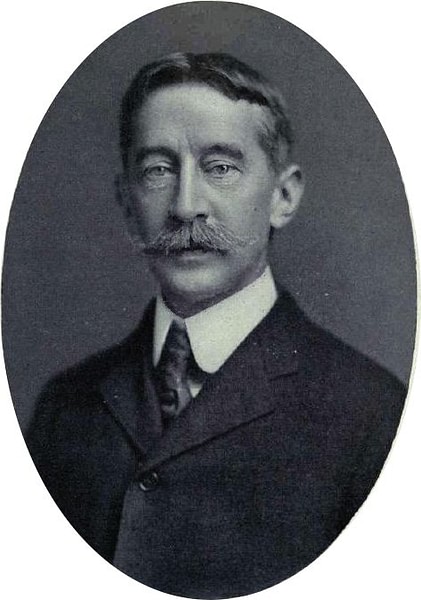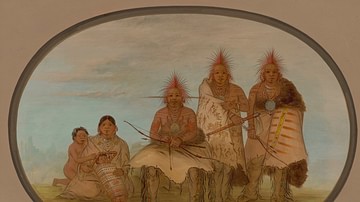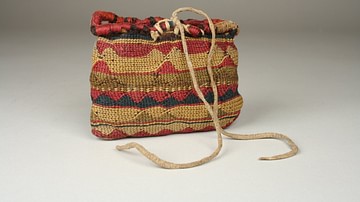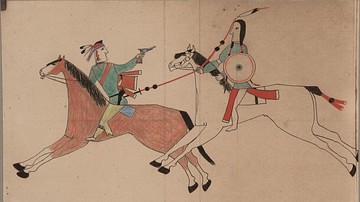The Boy Who Was Sacrificed is a legend of the Pawnee nation highlighting the belief that everything happens for a reason according to the will of Ti-ra'wa ("Father Above"), the supreme creator, and how even the smallest creatures have an essential part to play in the divine plan and are as worthy of respect as any other.
The story is among the best-known Pawnee legends, not only for its message but also because it features the sacred site of Pahaku (also known as Pahuk, Pahuk Hill, in modern-day Nebraska) which is considered the most supernaturally potent of five such sites (all mentioned in the tale) where the Nahu'rac – sacred animals who serve the will of Ti-ra'wa – have their homes. The Nahu'rac are mediators between the Pawnee and Ti-ra'wa, receiving messages from the divine and acting upon them, as well as sending along the prayers and sacrificial gifts of the people to the Father Above. The Nahu'rac appear in several Pawnee tales, including The Bear Man, which is, in part, an origin tale of the Pawnee Bear Dance.
In this story, a man acts on his belief that he must sacrifice his only son to receive blessings from Ti-ra'wa, but his offering is rejected through the intervention of the "little bird" (most likely the Interior Least Tern, a small bird that lives along the Platte River in Nebraska) who recognizes the boy should not have been killed and convinces the Nahu'rac to restore him. The reluctance of the Nahu'rac to act on this immediately would be due to their uncertainty as to whether the little bird, who is their servant, is acting in the interests of Ti-ra'wa or his own, but once the bird demands the boy be restored, it is assumed the Nahu'rac interpret this as a message from Ti-ra'wa.
Their hesitation might also reference a ritual in which one must visit the other four sites before returning to Pahaku to be made whole, as in another famous Pawnee tale, A Story of Faith, in which a young doctor is poisoned by another who is jealous of his skill and is taken by an elk round the homes of the Nahu'rac before he is cured. In that story, as in this one, the little bird plays a significant role in healing the young doctor.
In The Boy Who Was Sacrificed, once the boy is brought back to life, he receives the kind of blessings his father had hoped for but was denied. The story's central theme of good coming from bad frequently characterizes Pawnee tales, which emphasize the goodwill of Ti-ra'wa toward the people and how this is shown through one's interactions with the natural, or even the supernatural, world. In The Ghost Wife, for example, a Pawnee man convinces the ghost of his departed wife to return to him, and even though this does not work out as well as he had hoped, the story has a happy ending, as is also the case of this story of the boy and the mystical site of Pahaku.
Pahaku is still understood as a sacred site by the Pawnee in the present day, and in 2008, a conservation easement was granted for 257 acres (104 ha), including the sacred site, to be dedicated to perpetual preservation. Stories concerning the site, like The Boy Who Was Sacrificed, are still told in Pawnee communities, continuing the tradition of storytelling as the central means of transmitting cultural values and history.
Text
The following text is taken from Pawnee Hero Stories and Folk-Tales by anthropologist and historian George Bird Grinnell, first published in 1889. The original date of composition for the story is unknown as it was passed down through oral tradition until recorded by Grinnell.
THERE was a time, far back, when some people thought that it was good to sacrifice to Ti-ra'-wa whatever they had that was most precious to them. The sacrifice of the animal, the burnt offering, has always been made by all the Pawnees; that is one of the things handed down from the ruler. It is very old. The Skidi have always performed the sacrifice of the captive. Each one of these is sacred and solemn, but it is not like giving up something that belongs to you, and that you love. It is a sacrifice, but it does not cost much.
Many years ago, in the Skidi village on the Loup, there lived a man, who believed that if he sacrificed his son to Ti-ra'-wa, it would be a blessing to him. He thought that if he did this thing, perhaps Ti-ra'-wa would speak to him face to face, and that he could talk to him just as two people would talk to one another, and that in this way he would learn many things that other people did not understand. His child was a nice boy about ten years old, strong, growing up well, and the man loved him. It made him feel badly to think of killing him. He meditated long about this, but the more he thought about it, the more he believed that this sacrifice would please Ti-ra'-wa. There were many things that he wanted to understand, and to do; and he thought if he gave up his son, these good things would come to him. So, he resolved to make the sacrifice.
One morning he started out from the village and took the boy with him. They went over to the Platte. When they got to the river, as they were walking along, the man took his knife from its sheath, and caught the boy by the shoulder, and stabbed him quickly, and cut him open. When the boy was dead, he threw the body into the river, and then went back to the village. When he got there, he went into his lodge and sat down. After a time, he said to his wife, "Where is the boy?" The woman said, "He went out with you, when you went over to see the horses." The man answered, "No; I went out to where the horses are feeding, and looked at them, but he did not go with me."
The man went out, and looked for the boy all through the village, but he could not find him. At night when the boy did not come home, they began to get frightened, and for two days they hunted for the boy, and at last they got the old crier to call out for him from the top of the lodge, and ask if anyone had seen him, but none of the people knew what had become of the boy. Now the mother was mourning, and the father pretended to feel very badly. They could not find the boy; and soon after this the tribe started on the summer hunt, and the father and mother went with them. The village made a good hunt, killing plenty of buffalo, and made much dried meat.
After the boy had been thrown into the river, he floated down with the current, sometimes turning over and over in the swift water, and sometimes grounding for a little while on a sand bar, and then being floated off again, and being carried further down. At length he came near to the place where the whirlpool is, under the bluff at Pa-hŭk', where is the lodge of the Nahu'rac. There were two buzzards sitting on the bluff, just above this place, and as they sat there, one of them stretched out his neck and looked up the river, and after he had looked, he said to the other, "I see a body." Then both the buzzards flew down to where the boy was floating in the water, and got down under him, and raised him on their backs, and lifted him up out of the water, and flew up to the bluff, carrying the boy on their backs, and placed him on the ground on top of the bluff over the big cave, which is the home of the Nahu'rac. In this lodge were all kinds of animals, and all kinds of birds. There were bears, and mountain lions, and buffalo, and elk, and beaver, and otter, and deer, all kinds of animals, great and small, and all kinds of birds.
There is a little bird, smaller than a pigeon. Its back is blue, and its breast white, and its head is spotted. It flies swiftly over the water, and when it sees a fish, it dives down into the water to catch it. This bird is a servant or a messenger for the Nahu'rac. Such a bird came flying by just as the buzzards put the body on the ground, and he stopped and looked at it. When he saw how it was—for he knew all that had happened—he flew down into the lodge and told the Nahu'rac about the boy. The bird said, "There is a boy up here on the hill. He is dead, and he is poor, and I want to have him brought to life again." Then he told the Nahu'rac all the things that had happened. When the messenger bird had done speaking, the Nahu'rac earnestly counselled together for a long time to decide what should be done, and each one made a speech, giving his opinion about the matter, but they could not make up their minds what ought to be done.
The little bird was coaxing the Nahu'rac, and saying, "Come, now, we want to save his life." But the Nahu'rac could not decide. At last, the chief of the Nahu'rac said, "No, messenger, we cannot decide this here. You will have to go to the other council lodges and see what they say about it." The bird said, "I am going," and flew swiftly out of the lodge and up the river, till he came to the Nahu'rac lodge near the Lone Tree. When he got there, he told them all about the boy, and said that the council at Pa-hŭk' could not decide what should be done. The Nahu'rac here talked, and at last they said, "We cannot decide. The council at Pa-hŭk' must decide." Then the bird went to the lodge on the Loup, and the Nahu'rac there said that they could not decide Then he went to Kitz-a-witz-ŭk, and to Pa-hūr'; and at each place the Nahu'rac considered and talked about it, and then said, "We cannot decide what shall be done. The council at Pa-hŭk' must decide for themselves."
At last, after he had visited all the council lodges of the Nahu'rac, the bird flew swiftly back to the lodge at Pa-hŭk' and told them there what the animals at the other lodges had said. In the council of the Nahu'rac at Pa-hŭk', there were four chiefs, who sat there as judges to determine such matters as this, after they had all been talked over, and to decide what should be done. When the messenger bird came back and told the Nahu'rac what the other councils had said, these judges considered for a time, and then spoke together, and at length the chief of the judges said to the bird, "Now, messenger, we have concluded that we will not decide this question ourselves. You decide it and say what shall be done."
The messenger was not long in deciding. He did not hesitate. He said, "I want this boy brought back to life." Then all the Nahu'rac stood up, and went to where the boy lay, and stood around him and prayed, and at last the boy breathed once, and then after a little while he breathed again, and at last he came to life and sat up. He looked about and saw all these animals standing around him, and he wondered. He said to himself, "Why, my father stabbed me, and killed me, and now here I am among this great crowd of animals. What does this mean?" He was surprised.
The Nahu'rac all went back into the lodge and took the boy with them. When all were seated in the lodge, the four judges talked to each other, and the chief one stood up, and said, "Now, my people, we have brought this boy back to life, but he is poor, and we must do something for him. Let us teach him all we know and make him one of us." Then the Nahu'rac all made a noise. They were glad. Then they began to sing, and they danced. They taught the boy all their secrets, and all their ways. They taught him how to cut a man open and cure him again, and how to shoot an arrow through a man and then cure him, and how to cut a man's tongue out and then to put it back, and how to make well a broken leg, and many other things. After they had done all these things, they said to the boy, "Now we have brought you back to life, and have taught you all these things, so that you are one of us. Now you must stop with us one season. Your people have gone off on the summer hunt. You must stay with us until the autumn. Then you can go back to your people." So, the boy stayed with the Nahu'rac in their lodge.
At length the Skidi had returned from the hunt with plenty of dried meat. Soon after this, the Nahu'rac said one day to the boy, "Your people have got back from the hunt. Now you can go back to the village. Go back and get a lot of nice, dried meat, and bring it back to us here, and we will have a feast."
The boy went home to the village. He got there in the night, and went to his father's lodge, and went in. There was a little fire burning in the lodge. It was nearly out, and gave only a little light, but he knew the place where his mother slept. He went up to her, and put out his hand and touched her, and pushed her a little. She awoke, and sat up and looked at him, and he said, "I've come back." When she saw him, and heard him speak, she was very much surprised, and her heart was glad to see her boy again. She called to his father, and he woke up. When he saw the boy, he was afraid, for he thought it was a ghost. The boy told them nothing of what had happened, or where he had been. He just said, "I have come back again."
In the morning all the people were surprised to hear that he had come back, and to see him, and they stood around looking at him, and asking him questions, but he said nothing. The next day the people still questioned him, and at last the boy said, "I have been all summer with friends, with people who have been good to me. I should like to take them a present of some nice, dried meat, so that we can have a feast." The people said that this was good. They picked out four strong horses, and loaded them with dried meat, the nicest pieces. The boy's father gave some of it, and all the other people brought pieces and put them on the horses, until they had big loads. They sent two young men with the boy, to help him load and drive the horses, and they started to go to the Nahu'rac lodge at Pa-hŭk'.
When they had come pretty near the place, the boy sent the young men back to the village, and he went on alone, driving the packhorses before him. When he reached the home of the Nahu'rac, he unloaded the horses, and turned them loose, and then went into the lodge. When he went in, and when the Nahu'rac saw him, they all made a hissing noise. They were glad to see him. The boy brought into the lodge all the dried meat, and they had a great feast. After the feast they had a doctors' dance, and the boy was made a doctor, and again was taught all that the Nahu'rac knew. After that he could do many wonderful things. He could sometimes go to a man that had been dead for a day, and then bring him back to life.
No one ever knew what the father had done, for the boy never told anyone. He knew that he could never have learned all these wonderful things unless his father had sacrificed him.







